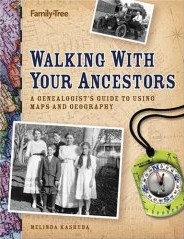Book Review: Walking with Your Ancestors by Melinda Kashuba
Walking with Your Ancestors: A Genealogist’s Guide to Using Maps and Geography
by Melinda Kashuba
Family Tree Books, 2005. Softcover, 226 pp. ISBN 1-55870-730-1
 I do other things besides this web site; one of these is to volunteer at the local archives, a private organization covering the surrounding county that’s based in my town. As is the case with most archives, large and small, most of our clientele and research activities are centred on genealogical research; as is also the case, much of our holdings is not necessarily of obvious use to genealogists. Amongst that material is our collection of maps (which I have to go through and organize at some point); our latest accession is a nifty fire insurance map of our town dating from the mid-1930s. Since most of our focus is on genealogy, though, the following question might be asked at some point: “Well, Jonathan, these maps are all very interesting, but what are they good for?”
I do other things besides this web site; one of these is to volunteer at the local archives, a private organization covering the surrounding county that’s based in my town. As is the case with most archives, large and small, most of our clientele and research activities are centred on genealogical research; as is also the case, much of our holdings is not necessarily of obvious use to genealogists. Amongst that material is our collection of maps (which I have to go through and organize at some point); our latest accession is a nifty fire insurance map of our town dating from the mid-1930s. Since most of our focus is on genealogy, though, the following question might be asked at some point: “Well, Jonathan, these maps are all very interesting, but what are they good for?”
It’s that very question, hypothetical though it may be in my case, that Melinda Kashuba’s book, Walking with Your Ancestors: A Genealogist’s Guide to Using Maps and Geography, answers. While Kashuba, a genealogical researcher with a Ph.D. in geographer, has the genealogical audience in mind, this book could, with a slight change in focus, easily serve as a general introduction to old maps held in American archives — how they were made, how to read them, and how to use them in your research.
In slightly more than two hundred pages, Kashuba covers a lot of ground. We get a lot about how to read old maps — including how to use a gazetteer, which is basic, and how to track down place names that may have changed or moved, which is not. We’re given a good deal of context behind those old maps: how counties were organized, how lands were surveyed, how topographic maps were made. We’re also introduced to the various kinds of map sources: cadastral surveys, county maps, military maps, and fire insurance maps. She even has a section on using GPS.
In her introduction, Kashuba argues that geography is more important to genealogy than history is — an ostensibly strange argument, but it’s hard to refute her assertion that place is central to genealogical research:
Genealogy is a geographically driven subject. There’s no question that history and historical events are important to tracing family trees; those names and dates are vital. But let’s face facts: Records are made and kept by location. That makes geography as important if not more important than history to the genealogist. Knowing where your ancestors lived is the key to finding “the really good stuff” in those records.
True enough, many of the researchers I’ve encountered have had trouble tracking down a name because they weren’t sure where to look. Adding maps to the search can suggest other avenues: if your great-great grandfather isn’t in this town, perhaps he’s in the town down the river — or perhaps he’s got records at the county seat. Among many other things, maps can suggest such connections.
Unfortunately, this book won’t be of much help in my archives; Kashuba’s book is American in scope. But this accessible, engaging book will no doubt be useful to genealogists across the U.S., and should probably be in every local archive’s reference shelf.
I received a review copy of this book. More on my book review policy.

Comments
blog comments powered by Disqus